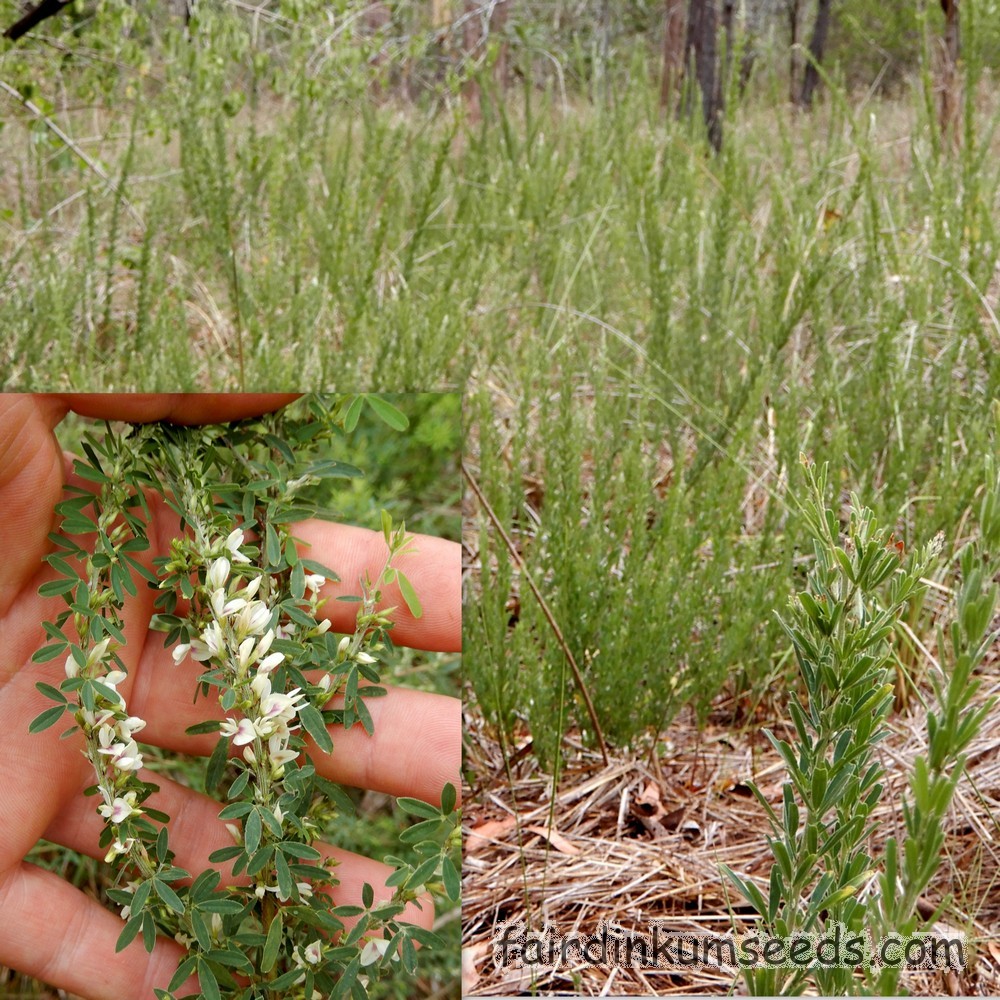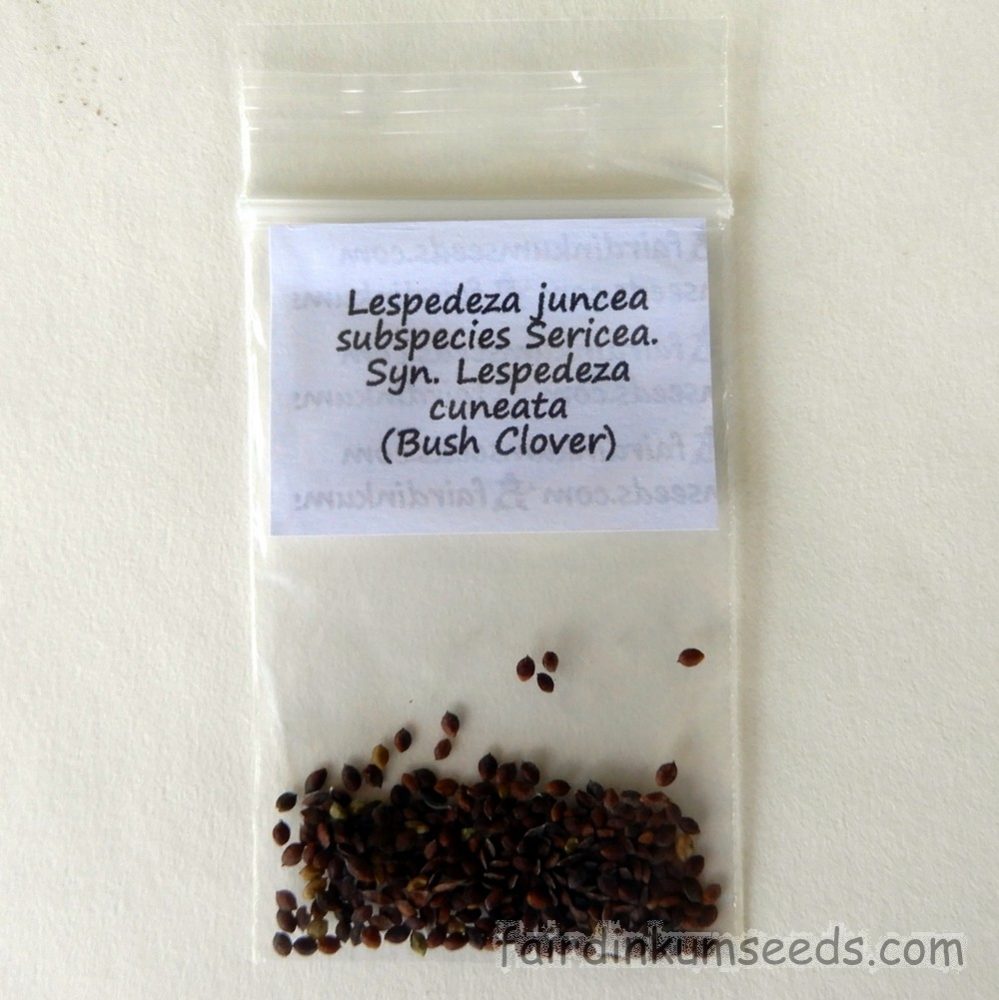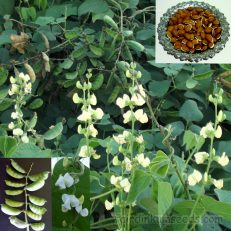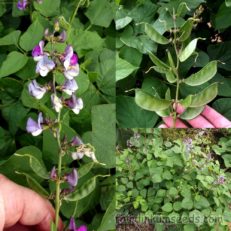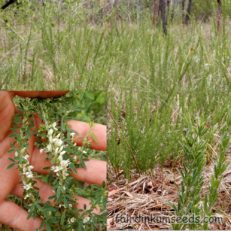Please read text!
Lespedeza Juncea Sericea Cuneata Bush Clover Seeds
Packet of 50+ home grown seeds!
These guys grow naturally in the valley here and are a major food source for the local wildlife.
Being nitrogen fixing plants they also help improve the soil conditions for nearby plants too.
On the cattle blocks in town they provide a substantial amount of fodder after burning off or when there is a little rain after a long dry spell.
The sort of rain that does bugger all to help the grasses, the stuff you hear folks whinge about.
That pathetic little amount that barely wets the topsoil, is still enough to kick it into action again.
It bounces back really fast and once established it handles the continuous heavy grazing very well due to the large deep root mass and spreading nature of it’s growth.
It reminds me a lot of asparagus, the way it continuously pushes out new shoots of tender new growth, always radiating outwards from the massive central tap root.
That central root is commonly a meter or more long making it ideal for preventing erosion and holding the topsoil together.
It survives drought and fire far better than many more common fodder species, and it’s seeds are very responsive to smoke.
They grow easily as is, but adding my Smoke Treatment to the soil or to the water the seeds are soaked in before planting makes germination rapid and even.
Without my fancy Smoke Treatment they will come up here and there in a very staggered and random way, as this is exactly what they were designed to do.
When things are normal they come up a couple at a time over a very long period to spread out the risk of getting eaten, and to cope with competition with grasses better.
Without the triggers of erosion or to a greater extent the chemicals created in the smoke of a bushfire, they can sit dormant in dry soils for many years.
After a fire there is little competition for resources, plenty of sun light and fertilisers, and a large % of the herbivores have moved on.
At these times they all sprout and grow rapidly, eager to mature and set seeds before grasses again become dominant.
It is native to Australia, and Asia, and it has been introduced to many places as a soil holding erosion preventing fodder crop and in a few places it has done too good a job and is now considered a weed.
Not only is it a nutritious fodder that is easy to grow, it is also considered to be a powerful vermicide because of the high levels of tannin’s in the plant.
As in, it kills parasitic intestinal worms in sheep and goats.
It kills them and it also prevents the eggs from hatching, and studies show as little as 2-4.5% massively decreases parasite load.
So much that it freed up funding for larger US government studies that showed even when commercially processed and pelleted, then mixed in with other more common fodders, it still had a massive effect at reducing parasite load.
When the feeding stopped, the parasite load increased immediately conclusively proving it’s effectiveness.
Unfortunately around that time the plant was officially declared a “noxious weed” in the USA with all future funding focused solely on eliminating it, not making use of it…
Now of course it could just be for environmental reasons, for sure, it is possible.
But some more cynical folks suggest the whole, “easy to grow, cost effective, hardy and nutritious fodder, that could potentially prevent the need for 100% reliance on the billion dollar agro-pharmacutical vermicide industry” could have something to do with it.
Now I’m not the sharpest crayon in the box, but it certainly makes me wonder….
Anyway, here in Australia it is not a weed anywhere, it is just another handy native.
It provides fodder, and the tannins of the plant itself may help to minimize the parasite load of your critters, especially sheep and goats.
In degraded pastures it can improve the soil via nitrogen fixation while at the same time it helps to hold the topsoil and prevent erosion, providing lots of feed in harsh times like after burning off or extended dry times.
It also produces nectar for the bees and pretty white flowers that look really cool on mass.
It’s very nice and very often overlooked plant, as it isn’t really a grass or a shrub, it’s kinda in between.
I reckon it would be ideal for roundabouts and street side garden beds in public areas as it can handle whatever you throw at it and with a little water every now and then it becomes a dense lush hedge of individual upright stems.
Overseas it is native to Afghanistan, Assam, China, Himalaya, Korea, Japan, Malaysia, China, Indonesia, Java, North Korea, Papua New Guinea, Philippines, South Korea, Taiwan, Vietnam and a few other places, and because of this huge range it is known by the common names, bisuri, bush clover, Chinese bush-clover, Chinese bush clover, Chinese lespedeza, jie ye tie sao zhou, lespedeza de chine, lespedeza perenne, lespedeza perenne, lespedeza soyeux, lespedeza soyeux, medohagi, perennial lespedeza, perennial lespedeza, seidenhaarbuschklee, Siberian lespedeza, silky bush-clover, silky bush clover.
It has also been known by the following botanical synonyms.
Anthyllis cuneata, Hedysarum junceum, Hedysarum sericeum, Lespedeza aitchisonii, Lespedeza cuneata, Lespedeza cystoides, Lespedeza cytisoides, Lespedeza hedisaroides, Lespedeza hedysaroides, Lespedeza hedysaroides var. subsericea, Lespedeza jumcea var. subsericea, Lespedeza juncea var. subsericea, Lespedeza sericea, Trifolium cytisoides, and Trifolium hedysaroides.
Here in Australia we consider it Lespedeza juncea subsp. sericea while overseas it is most often known as Lespedeza cuneata.
Whatever you want to call it, I reckon its cool and it should really be wider promoted and studied.
Sustainably wildharvested by me and the Mrs, no chems, no nasties, no problems!!!
